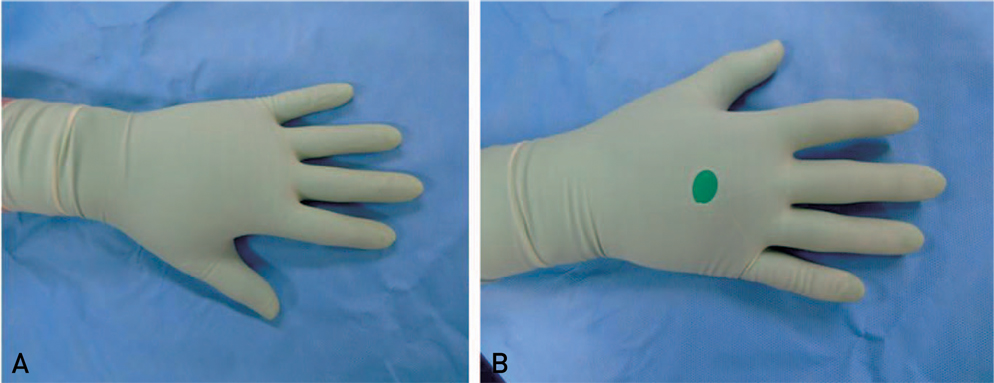Hip Pelvis.
2015 Mar;27(1):17-22. 10.5371/hp.2015.27.1.17.
Perforation of Surgical Gloves during Lower Extremity Fracture Surgery and Hip Joint Replacement Surgery
- Affiliations
-
- 1Department of Orthopedic Surgery, Daegu Catholic University College of Medicine, Daegu, Korea. cmr0426@cu.ac.kr
- 2Department of Orthopedic Surgery, Seogwipo Medical Center, Seoqwipo, Korea.
- KMID: 2156015
- DOI: http://doi.org/10.5371/hp.2015.27.1.17
Abstract
- PURPOSE
To assess the frequencies and sites of surgical glove perforations in lower extremity fracture surgery and hip joint replacement (HJR) surgery. Additionally, we also studied the usefulness of an indicator system glove.
MATERIALS AND METHODS
We assessed surgical glove perforations in 30 cases of lower extremity fracture surgery and 18 cases of HJR surgery conducted by one right handed 1st operator from April 2013 to July 2013. We assessed frequencies and sites of perforation in 152 gloves; 95 used in lower extremity fracture surgery and 57 used in HJR surgery. We studied the perforation rates and sites according to participants and operation types. Using the Biogel indicator system glove, which is well known as a fast indicator of glove perforation, we were also able to assess the time difference between operative participant detection of perforation and inspector nurse detection while observing in the operative field.
RESULTS
There were 18 of 30 cases in lower extremity fracture surgeries and 12 of 18 cases in HJR surgeries which had more than one surgical glove perforation event. Of all 152 gloves used, perforation occurred in 15 of 57 gloves (26.3%) in HJR surgery and 23 of 95 gloves (24.2%) in lower extremity fracture surgery. Perforation occurred more frequently in operators than assistant doctors or scrub nurses. The most frequent perforation site was the second digit of the left hand. On average, the time difference between operative participant notice of perforation and inspector nurse notice of perforation was 20.6 seconds.
CONCLUSION
The perforation of surgical gloves happened in approximately one out of every four persons. Importantly, we noted a 37.0% prevalence of glove perforation in 1st operators. Considering that glove perforation is a critical factor responsible for intra-operative infection, surgeons must be conscious of the risk of surgical glove perforation and use double gloving regularly. Furthermore, indicator double gloving is recommended for fast detection of outer glove perforation.
Figure
Reference
-
1. Aarnio P, Laine T. Glove perforation rate in vascular surgery--a comparison between single and double gloving. Vasa. 2001; 30:122–124.2. Dodds RD, Guy PJ, Peacock AM, Duffy SR, Barker SG, Thomas MH. Surgical glove perforation. Br J Surg. 1988; 75:966–968.
Article3. Hollaus PH, Lax F, Janakiev D, Wurnig PN, Pridun NS. Glove perforation rate in open lung surgery. Eur J Cardiothorac Surg. 1999; 15:461–464.
Article4. Misteli H, Weber WP, Reck S, et al. Surgical glove perforation and the risk of surgical site infection. Arch Surg. 2009; 144:553–558.
Article5. Wong PS, Young VK, Youhana A, Wright JE. Surgical glove punctures during cardiac operations. Ann Thorac Surg. 1993; 56:108–110.
Article6. Laine T, Aarnio P. Glove perforation in orthopaedic and trauma surgery. A comparison between single, double indicator gloving and double gloving with two regular gloves. J Bone Joint Surg Br. 2004; 86:898–900.7. Nicolai P, Aldam CH, Allen PW. Increased awareness of glove perforation in major joint replacement. A prospective, randomised study of Regent Biogel Reveal gloves. J Bone Joint Surg Br. 1997; 79:371–373.8. Naver LP, Gottrup F. Incidence of glove perforations in gastrointestinal surgery and the protective effect of double gloves: a prospective, randomised controlled study. Eur J Surg. 2000; 166:293–295.
Article9. Laine T, Aarnio P. How often does glove perforation occur in surgery? Comparison between single gloves and a double-gloving system. Am J Surg. 2001; 181:564–566.
Article10. Jensen SL, Kristensen B, Fabrin K. Double gloving as self protection in abdominal surgery. Eur J Surg. 1997; 163:163–167.11. Marín-Bertolín S, González-Martínez R, Giménez CN, Marquina Vila P, Amorrortu-Velayos J. Does double gloving protect surgical staff from skin contamination during plastic surgery? Plast Reconstr Surg. 1997; 99:956–960.
Article12. Matta H, Thompson AM, Rainey JB. Does wearing two pairs of gloves protect operating theatre staff from skin contamination. BMJ. 1988; 297:597–598.
Article13. Brown JN. Surgeon protection: early recognition of glove perforation using a green under glove. J R Coll Surg Edinb. 1996; 41:395–396.14. Thanni LO, Yinusa W. Incidence of glove failure during orthopedic operations and the protective effect of double gloves. J Natl Med Assoc. 2003; 95:1184–1188.15. Duron JJ, Keilani K, Elian NG. Efficacy of double gloving with a coloured inner pair for immediate detection of operative glove perforations. Eur J Surg. 1996; 162:941–944.16. Beldame J, Lagrave B, Lievain L, Lefebvre B, Frebourg N, Dujardin F. Surgical glove bacterial contamination and perforation during total hip arthroplasty implantation: when gloves should be changed. Orthop Traumatol Surg Res. 2012; 98:432–440.
Article17. Kaya I, Uğrąs A, Sungur I, Yilmaz M, Korkmaz M, Cetinus E. Glove perforation time and frequency in total hip arthroplasty procedures. Acta Orthop Traumatol Turc. 2012; 46:57–60.
Article18. Kojima Y, Ohashi M. Unnoticed glove perforation during thoracoscopic and open thoracic surgery. Ann Thorac Surg. 2005; 80:1078–1080.
Article19. Caillot JL, Côte C, Abidi H, Fabry J. Electronic evaluation of the value of double gloving. Br J Surg. 1999; 86:1387–1390.
Article
- Full Text Links
- Actions
-
Cited
- CITED
-
- Close
- Share
- Similar articles
-
- Arthroscopic Management of Intraarticular Screw Perforation after Surgical Treatment of an Acetabular Posterior Wall Fracture: A Case Report
- Focal Myositis around Hip Joint: 3 Cases Report
- Primary Total Hip Replacement in the Lower Limb Amputees
- Functional Review of the Hemiarthroplasty Vs, Total Joint Replacement in the Femur Neck Fracture
- Biomechanics of Hip and Hip Replacement Arthroplasty


